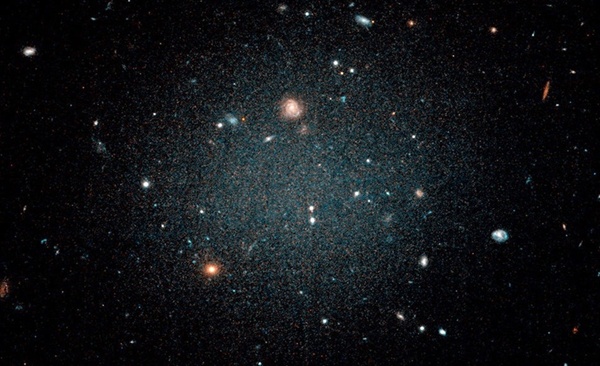Astronomers find 19 more galaxies missing their dark matter – Astronomy Magazine
NGC1052-DF2, imaged here by the Hubble Space Telescope, is a large, but very diffuse galaxy thought to contain a negligible amount of dark matter.
NASA/ESA/P. van Dokkum (Yale University)
But after an academic back-in-forth, where Trujillo and van Dokkum traded salvos in the form of research papers, the answer to whether these galaxies are really missing their dark matter still remains uncertain.
A growing list of galaxies without dark matter
But now, the discovery of 19 more galaxies without dark matter makes DF2 and DF4 seem less bizarre. And if the latest results hold up, astronomers will have to seriously consider what this growing population of galaxies without dark matter means.
The latest batch of galaxies missing dark matter was discovered when Guo and her team explored the nature of 324 dwarf galaxies using data from the Arecibo Observatory in Puerto Rico and the Sloan Digital Sky Survey. With this data, they followed in the footsteps of Rubin and Ford, studying how fast hydrogen gas rotates around each galaxy. They also calculated how much normal matter — in the form of both gas and stars — they contained.
After crunching the numbers, Guo and her colleagues determined that, of the 324 dwarf galaxies they investigated, 19 of them contain enough visible matter to solely explain the motions of the galaxies’ hydrogen. In other words, a lot of dark matter seems to be missing from these galaxies.
According to the study, “Our results suggest that a population of dwarf galaxies could form in a particular way such that much less dark matter is required than for those in the Local Group [our cosmic neighborhood] and those found in simulations.”
And what’s the significance of finding galaxies without dark matter? According to van Dokkum, it would mean that astronomers don’t really understand how galaxies form in the first place. Scientists currently suspect galaxies only form when the gravity from copious amounts of dark matter attracts the gas and dust needed to kick-start star formation.
“The thing is, we have no idea how star formation would proceed in the absence of dark matter,” van Dokkum explained. “All we can say is that there must have been very dense gas early on in their history.” Otherwise, the galaxies wouldn’t be able to create any new stars.
Moving forward, Guo and her team say that astronomers need to do more work to map the motions of hydrogen gas within these galaxies. And with that, they hope to learn more about how these galaxies without dark matter came to be in the first place.






